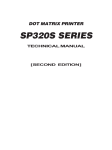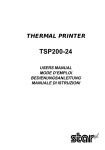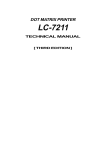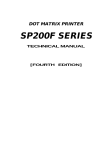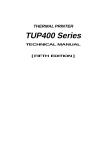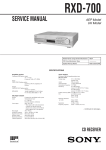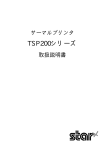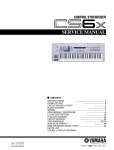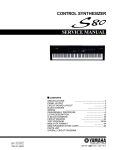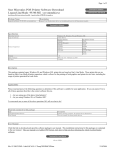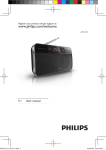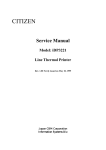Download Star Micronics TSP200 User's Manual
Transcript
THERMAL PRINTER TSP200 Series TECHNICAL MANUAL [SECOND EDITION] NOTICE • All rights reserved. Reproduction of any part of this manual in any form whatsoever, without STAR’s express permission, is strictly forbidden. • The contents of this manual are subject to change without notice. • All efforts have been made to ensure the accuracy of the contents of this manual at the time of printing. However, should any errors be found, STAR would greatly appreciate being informed of them. • The above notwithstanding, STAR can assume no responsibility for any errors in this manual. © Copyright 1997 Star Micronics Co., LTD. INTRODUCTION This manual describes the thermal printer TSP200 series. It is designed for use as a reference for periodic inspections and maintenance procedures to be executed by service personnel. It is not intended for the general user. Users of this manual should have a basic knowledge and understanding of the English language. • This manual is comprised of the following chapters. Chapter 1 Specifications and Operation Chapter 2 Theory of Operation Chapter 3 Parts Replacement and Related Adjustments Chapter 4 Maintenance and Lubrication Chapter 5 Parts Lists • First edition : Mar. 1997 Second edition : Aug. 1999 ■ Model Name TSP 2 1 2 — 120 Voltage 24 : 24VDC 120 : 120VAC 230 : 230VAC Mechanism type 2: 48 columns Printer type 1: Standard 4: With auto-cutter TSP200-series thermal printer 1 2 3 4 5 CHAPTER 1 SPECIFICATIONS AND OPERATION 1. General Specifications.......................................................................................... 3 2. External Appearance............................................................................................. 4 3. DIP-Switch Settings .............................................................................................. 5 4. Using the control panel to adjust the sensors, select the head rank, and set the memory switches. ........................................................................................... 6 5. Running a test print .............................................................................................. 8 6. HEX dump mode.................................................................................................... 8 1 SPECIFICATIONS AND OPERATION –2– SPECIFICATIONS AND OPERATION General Specifications Printing method Resolution Printable width Printing speeds Printable characters Bar codes Character matrix Interfaces Dimensions Weight Power Power consumption Operating environment Storage environment 300, 000 cuts 25.4mm (1 inch) 193mm Automatic paper cutter Life Min. cut length Line thermal direct 8 dots/mm (H) × 8 dots/mm (V) 72 mm 50 mm/sec (max.) ANK, International JAN, EAN, UPC, Code 39, ITF, Code 128, Code 93, NW-7 12 × 24 dots RS-232C, Parallel TSP212-120/230 : 158(W) × 234(D) × 193(H) mm TSP242-120/230 : 158(W) × 234(D) × 193(H) mm TSP212-24 : 158(W) × 239(D) × 193(H) mm TSP242-24 : 158(W) × 239(D) × 193(H) mm TSP212-120/230 : 2.8kg TSP242-120-230 : 3.0kg TSP212-24 : 1.8kg TSP242-24 : 2.0kg AC adapter : 350g AC cable : 150g AC120V, AC230V, DC24V Max. 43 W Avg. 19W (During continuous printing of ASCII characters) +5˚C ~ +40˚C 25% ~ 85% RH –20˚C ~ +60˚C 10% ~ 90% RH 15 8m m 193mm 1. ) 30 0/2 2 1 ) 24 12 P2 212S T m( (TSP 4m 23 9mm 23 15 8m m (TSP212) ) 30 0/2 2 1 ) 42 2-24 P2 TS SP24 ( m (T 4m 23 9mm 23 (TSP242) Fig. 1-1 External Dimensions –3– SPECIFICATIONS AND OPERATION 2. External Appearance Printer cover Protects the printer from dust and reduces noise. Do not open the cover while printing. Control panel Features two control switches and two indicators to indicate printer status. AC power cord Plugs into an outlet of the specified voltage. Shape of AC power plug will vary according to destinations. Interface connector Connects the printer with host computer. [ TSP200-120/230 ] Peripheral unit drive circuit connector Connects to peripheral units such as cash drawers, etc. Do not connect this to a telephone. AC adapter cable connector For connection of the AC adapter. Never unplug the AC adapter while the printer is on. [ TSP200-24 ] Fig. 1-2 External Appearance –4– SPECIFICATIONS AND OPERATION 3. DIP-Switch Settings Be sure to turn the power to both the printer and host computer off before changing the setting of the DIP switches. Power off DIP switch 1 ON OFF 8 DIP switch 1 1 4 DIP switch 2 Fig.1-3 DIP switch array DIP switch #1 The factory settings of DIP switch 1 are all on. Switch 1-1 1-2 1-3 1-4 1-5 1-6 1-7 1-8 Baud Rate 2400BPS 4800BPS 9600BPS 19200BPS Contents Baud Rate ON Data Length Parity Check Parity Selection Handshake Operating Mode Interface 8 bit Disabled Odd DTR/DSR Star RS232C 1-1 OFF ON ON OFF OFF 7 bit Enabled Even XON/XOFF ESC/POS Parallel 1-2 OFF OFF ON ON DIP Switch #2 Factory settings: 2-1 and 2-2 are on; 2-3 and 2-4 are off. Switch 2-1 2-2 2-3 2-4 Contents Print Density ON Serial I/F No. 6 Pin Reset Signal Serial I/F No. 9 Pin Reset Signal Print Density Light Standard Somewhat Heavy Heavy 2-1 OFF ON ON OFF Enabled Enabled 2-2 OFF ON OFF ON –5– OFF Disabled Disabled SPECIFICATIONS AND OPERATION 4. Using the control panel to adjust the sensors, select the head rank, and set the memory switches. Hold down the FEED and ONLINE switches while setting power on, then continue to hold the switches down for the time necessary to enter the required mode, as indicated below. Start Buzzer beeps 1 time. Press both switches. Continue to hold down. Release within 2 seconds. Enters "Adjust Paper-Out Sensor" mode. Buzzer beeps twice. Release within 2 seconds. Both switches Continue to hold down. Enters "Adjust Paper-Near-End Sensor" mode. Buzzer beeps 3 times. Release within 2 seconds. Both switches Enters "Set Head Rank" mode. Continue to hold down. Buzzer beeps 4 times. Release within 2 seconds. Both switches. Enters "Set Memory Switches" mode. Continue to hold down. Buzzer beeps 5 times. Release within 2 seconds. Both switches Continue to hold down. Resets, then executes test print. –6– SPECIFICATIONS AND OPERATION (1) “Adjust Paper-Out Sensor” mode. Adjustment is not necessary if the ONLINE lamp is ON when you enter this mode. If the lamp is OFF, the turn VR1 clockwise until it the lamp comes ON. To exit this mode, press ONLINE. To move back to the start of the sequence, press both ONLINE and FEED at the same time. Please be sure that paper is inserted before entering this mode. (2) “Adjust Paper-Near-End Sensor” mode When you enter this mode, the POWER lamp will be lit if the near-end sensor is detecting paper. The lamp will be off if no paper is detected. To exit the mode, press ONLINE. To move back to the start of the sequence, press both ONLINE and FEED at the same time. (3) “Set Head Rank” mode When you enter the mode, the ONLINE and POWER lamps will both be OFF. Press the FEED switch as necessary to select the desired rank. The rank is indicated by the ONLINE and POWER lamp pattern, which changes each time you press the switch. The change sequence is indicated below. (Note that you can move back to the start of the sequence by pressing the ONLINE and FEED switches at the same time.) ONLINE lamp OFF OFF ON ON (4) FEED lamp OFF ON OFF ON Head Rank A B C C “Set Memory Switches” mode 1 When you first enter this mode, memory switch 0 is selected. You can change the selection by pressing FEED as many times as necessary. Specifically, the selection cycle is 0 -> 1 -> 2 -> 3 -> 4 -> 0 -> 1 ->... In other words, press 0 times to select Switch 0, 1 time to select Switch 1, and so on. 2 Press ONLINE once to confirm your selection. The buzzer beeps one time in response. 3 Set a value for each bit in turn, starting from Bit F and proceeding sequentially to Bit 0. Note that the lamps indicate each bit’s current value: ONLINE lamp ON means that the current value is “1”, while POWER lamp ON means that the current value is “1”. To set to 0: Press FEED. (The buzzer will beep once.) To set to 1: Press ONLINE. (The buzzer will beep once.) When you complete setting of Bit 0, the buzzer will beep again. 4 When you have set all bit values and are ready to enter the new value, press the ONLINE switch. The buzzer beeps once and the value is written to memory. If you wish to cancel your changes, press the FEED switch instead. The buzzer will beep twice and the process will return to the beginning of Step (3) above. 5 Press the ONLINE and FEED switches at the same time to move back to the start of the sequence. –7– SPECIFICATIONS AND OPERATION 5. Running a test print To generate a test print, hold down the FEED switch while setting the power on. 6. HEX dump mode To enter HEX dump mode, hold down the ONLINE switch while setting the power on, and then release the switch after the buzzer beeps once. When this mode is active, all data sent from the host will be printed in HEX form. –8– CHAPTER 2 PRINCIPLES OF OPERATION This chapter describes the operating principles of the circuitry and printer mechanism. 1. Block Diagram ..................................................................................................... 11 2. Interface ............................................................................................................... 13 2-1. Interface Types ..................................................................................................... 13 2-1-1. RS232 interface ................................................................................................ 13 2-1-2. Parallel interface ............................................................................................... 14 2-2. Data Arrangement and Printing ........................................................................... 15 2-2-1. Arrangement ..................................................................................................... 15 2-2-2. Thermal printhead ............................................................................................ 15 2-2-3. Head current control ........................................................................................ 16 2-2-4. Head current control ........................................................................................ 18 2-2-5. Head burnout protection ................................................................................. 18 3. 2-3. Feed-Motor Drive Circuit ...................................................................................... 19 2-4. Power-On Reset Circuit ....................................................................................... 21 2-5. +5V Line Voltage Detector Circuit ....................................................................... 22 Printer Mechanism .............................................................................................. 23 3-1. Thermal Printhead ................................................................................................ 23 3-2. Paper-Feed Mechanism ....................................................................................... 23 3-3. Detectors ............................................................................................................... 24 3-4. Auto-Cutter Drive circuit (on TSP242-24/120/230 only) .................................... 25 2 PRINCIPLES OF OPERATION – 10 – PRINCIPLES OF OPERATION 1. Block Diagram The following diagram illustrates the relation between the main logic board and its peripherals. Main Logic Board Host computer Parallel I/F Dipswitch Lamp EEPROM Printer mechanism Head driver Thermal head PSRAM 128K × 8 bits Motor driver Paper-feed motor Kanji ROM 512K × 8 bits Cutter driver Auto-cutter Sensor circuit Sensor Gate array EPROM 256K × 8 bits Peripheral unit driver CPU Host computer RS232C I/F 5V Switch 24V Power supply unit Fig. 2-1 Block Diagram – 11 – Peripheral unit PRINCIPLES OF OPERATION (1) Main Logic Board The main logic board’s CPU passes data transmitted from the host computer into the local RAM. It then reads the data from the RAM, arranges it in accordance with the ROM program, and prints the results by issuing appropriate drive signals to the printer mechanism. [Block Descriptions] a. CPU: HD6413002F16 CMOS single-chip computer. Controls overall printer operation. b. EPROM: 256K × 8 bits Stores the CPU control program. c. PSRAM: 128K × 8 bits Work area and data buffer. d. EEPROM: 1024 bits Stores printer settings. Settings can be changed by software. (Used in place of dip switches.) e. Interface Interfaces the main board with the host computer. Two versions available: RS232C and Centronics. f. Gate array Handles signal input, output, and conversions. g. Drivers The various drivers convert signals received from the CPU and gate array into drive signals that directly control the printer mechanism. (2) Printer Mechanism Comprised of thermal head, platen, paper-feed motor, auto-cutter, and sensor mechanism. (3) Power Supply Unit Converts primary power to DC5V, DC24V. (4) Peripheral Unit External device (such as cash drawer) driven by signals issued from the main logic board. – 12 – PRINCIPLES OF OPERATION 2. Interface 2-1. Interface Types 2-1-1. RS232 interface CN6 IC10 IC1 CPU RXD RXD 0 TXD TXD 0 DSR P93 DTR P91 ADM232LJR RTS TTL 232C FAULT TTL 232C INIT P94 Comparator Dipswitch 2-3 Comparator Dipswitch 2-4 Fig. 2-2 Serial Interface Data flow from host to printer: IC10 receives serial data from the host through RXD, converts the voltage level from RS232C to TTL, and passes the result to the CPU. The CPU converts the serial data to parallel form and stores the result into buffer memory. Data flow from printer to host: The CPU generates the data, converts it into serial form, then passes it to IC10. IC10 converts the level from TTL to RS232C and outputs the result over the TXD line. – 13 – PRINCIPLES OF OPERATION 2-1-2. Parallel interface CN4 IC4 IC1 DATA 1 CD0 DATA 2 CD1 DARA 3 CD2 DATA 4 CD3 DATA 5 CD4 DARA 6 CD5 DATA 7 CD6 DATA 8 CD7 STROBE CSTB IC5 BUSY BUSY ACK ACK CPU ERROR ERROR SELECT SELECT PAPER OUT POUT Gate array LS05 Fig. 2-3 Parallel interface When the printer is ready (BUSY is LOW), the host computer transmits eight bits of parallel data (DATA1,...,DATA8) to CN4. The data passes through the gate array and moves into the CPU. Printer signals from the CPU (ACK, ERROR, SELECT, PAPER OUT, etc.) pass through the gate array and are output over the appropriate connector pins. – 14 – PRINCIPLES OF OPERATION 2-2. Data Arrangement and Printing 2-2-1. Arrangement The CPU reads data sequentially from RAM and arranges this data in accordance with program instructions stored in EPROM. The arranged data is then converted from parallel to serial form. The gate array then outputs the resulting serial data to the drive controller in the thermal printhead. 2-2-2. Thermal printhead The thermal printhead has 576 heat elements. Printing is executed by switching these elements ON and OFF as required. The printhead contains a built-in dedicated drive controller. The controller consists of shift register, latch circuit, and driver circuit, as illustrated below. The controller receives serial data (SI) from the gate array in sync with the CLK signal. It latches this incoming data (by LATCH signal), then outputs the data to the elements in sync with the falling edge of the STROBE signal. A data value of LOW corresponds to an element value of ON (generating print). R576 R1 VH DATE IN (SI) 1 2 3 4 5 6 7 B. E. O LATCH CLOCK STROBE4 STROBE3 STROBE2 STROBE1 Fig. 2-4 Drive Circuitry of Thermal Printhead – 15 – 8 9 SO PRINCIPLES OF OPERATION DO1 DO2 DO3 DO62 DO63 DO64 GNDH VDD BUFFER GNDL VDD CHECKER VDD STB BEO Q L Q D L Q D L LATCH Q L D Q D L Q D L D LAT CTL D Q SI C D Q C D Q C SHIFT REGISTER D Q D Q D Q C C C SO CLK Fig. 2-5 Block Diagram of Drive IC 2-2-3. Head current control Although the thermal printhead has four different STROBE lines, in fact it uses only three strobe signals to control its 576 elements. Specifically, each signal drives 192 of these elements. The signal/element arrangement is shown below. Thermal Printhead STROBE1 STROBE2 STROBE3 STROBE4 Elements 1 – 192 193 – 256 257 – 384 385 – 576 Strobe Signal STB1 STB2 STB3 – 16 – PRINCIPLES OF OPERATION Strobe signals are output in one of five patterns, depending on the number of dot lines that are simultaneously ON. The following table shows each of the patterns. Figure 2-7 shows the timing for Pattern (5). Strobe Signal Output STB1 STB2 STB3 Number of ON Elements per Dot Line Pattern 0 STB1+STB2+STB3 384 STB1 STB2 1 STB3 193 STB1+STB2+STB3 384 STB1+STB2 192 STB1 STB2 2 STB3 193 STB1+STB2+STB3 384 STB1+STB3 192 STB1 STB2 3 STB3 193 STB1+STB2+STB3 384 STB2+STB3 192 STB1 STB2 4 STB3 385 STB1+STB2+STB3 576 STB1 STB2 STB3 STB1: Number of ON elements in element range 1 to 192. STB2: Number of ON elements in element range 193 to 384. STB3: Number of ON elements in element range 385 to 576. Fig. 2-6 Strobe Signal Output Patterns for Different Print Rates – 17 – 5 PRINCIPLES OF OPERATION CLOCK SI LATCH 24V COMMON STB1 STB2 STB3 Fig. 2-7 Timing Chart 2-2-4. Head current control Heat buildup in the thermal printhead can cause print quality to degrade. To maintain uniform quality, the printer varies the energizing time (time that STROBE remains LOW) in accordance with the head temperature. The print head’s surface temperature is calculated based on the resistance value of the attached thermistor, and energizing time is controlled accordingly. 2-2-5. Head burnout protection Misoperation of the CPU may cause head current to remain on too long, resulting in burn damage to the elements unless current is shut off by other means. The printer therefore includes a burnout protection circuit that automatically forces current off at some fixed time tw following current startup. Control is implemented through the head’s BEO terminal, which is active on HIGH; setting the terminal LOW forces current off regardless of the STROBE state. CEXT REXT +5V CN6 IC1 CPU HD ON B Q BEO IC6 tw=(CEXT) (REXT) Fig. 2-8 Head Burnout Protection Circuit – 18 – PRINCIPLES OF OPERATION STB1 STB2 STB3 HD ON (B) Trigger Retrigger Retrigger BEO (Q) tw Fig. 2-9 Timing Chart 2-3. Feed-Motor Drive Circuit The printer uses a 4-phase step motor (phase 1-2 excitation) to implement paper feed. The motor rotates through a certain angle each time it receives a pulse from the drive circuit. The following diagram illustrates the excitation method. Figure 2-11 shows the feed-motor drive circuit. ON 1 ON ON 2 ON 3 ON 4 Step 1 2 3 4 5 6 7 8 Forward Feed Reverse Feed Fig. 2-10 Motor Control by Phase 1-2 Excitation IC1 CPU +24V DT9 TR5 PB4 CN7 1 2 TA1 TP8 TP9 TP10 TP11 6 1 3 2 5 3 4 4 M-GND Fig. 2-11 Feed-Motor Drive Circuit – 19 – PRINCIPLES OF OPERATION The feed-motor pulse width varies according to the strobe output pattern (where the output pattern is determined by the print rate, as described above). The following diagram shows the pulse width for each pattern. Pattern 1 STB1 STB2 STB3 LF COMMON T1 T1 T1 Pattern 2 STB1 STB2 STB3 LF COMMON T2 T2 T2 Pattern 5 STB1 STB2 STB3 LF COMMON T3 T3 Fig. 2-12 Pulse Width by Pattern – 20 – T3 PRINCIPLES OF OPERATION 2-4. Power-On Reset Circuit The power-on reset signal initializes all elements so as to protect against possible operating errors at power-on. The signal is held for approximately 160ms when power comes on. The reset circuit is shown below. Fig. 2-13 Power-On Reset Circuit +5V +5V +5V IC4 Drive circuit +5V IC3 IC1 : CPU VCC +5V RESET CPU CD RES OUT RESO + C9 Gate array GND D1 RESET IC Fig. 2-13 Power-On Reset Circuit 1 At power-on, voltage detector IC3 (M51953BL) outputs a LOW signal from its OUT terminal. The signal is held for approximately 160ms by the action of capacitor C9 (0.47µF), in accordance with the following relation: T = 0.34 × C9 (pF) [µs] = 160ms 2 The LOW signal generates reset of the CPU and gate array, and stops operation of the mechanism drive circuitry. – 21 – PRINCIPLES OF OPERATION 2-5. +5V Line Voltage Detector Circuit The voltage-detection IC (IC3 in Fig. 2-13) detects momentary drops or unstable levels in the +5V line voltage. The following shows an IC3-equivalent circuit. VCC 1 SµA typ R1 5 – OUT – + R2 1.25V 3 GND 4 Cd Fig. 2-14 Equivalent Circuit, Voltage Detection IC Figure 2-15 shows the IC’s operational timing. The IC asserts a reset signal at its output terminal when the -5V line voltage falls below 4.25V, thereby resetting the CPU and the gate array. VCC Voltage 4.25V 0.8V t Output Voltage td td t td = 0.34 × Cd (pF) [µs] Fig. 2-15 Operation Timing Chart – 22 – PRINCIPLES OF OPERATION 3. Printer Mechanism 3-1. Thermal Printhead The TSP400 printers utilize thermal line printing. The thermal printhead consists of a horizontal line of 576 heat elements. These elements print one line of dots at a time as the paper passes over the head. The printhead is fixed in position; only the paper moves. The printer prints a dot by heating the corresponding heat element. The heated element generates a chemical reaction in the coloring layer of the thermal paper, resulting in the formation of a visible dot. Thermal head Heat element Coloring layer Thermal paper Printed point Platen Fig. 2-16 Principle of Thermal Printing 3-2. Paper-Feed Mechanism The paper-feed mechanism is comprised of paper-feed motor, gear train, platen, and thermal printhead. The paper-feed motor drives the gear train, which in turn rotates the platen. The platen carries the thermal paper past the printhead. The paper-feed motor is a PM (permanent magnet) type, 4-phase 48-pole step motor. 3 steps feed the paper approximately 0.125mm. Thermal paper Gear train Platen Paper-feed motor Thermal head Fig. 2-17 Paper-Feed Machanism – 23 – PRINCIPLES OF OPERATION 3-3. Detectors 1 Paper-Out Detector The paper-out detector (reflective photosensor) is located at the paper entry slit. The photosensor’s phototransistor remains ON while paper is present. It goes OFF when paper runs out, generating output of a paper-out signal. IC1 CPU CN2 +5V +5V Paper 4 – P45 Photosensor + +5V 5 3 Fig. 2-18 Paper-Out Detector 2 Paper-Near-End Detector The near-end detector is mounted in the paper-roll holder. CN3 IC1 CPU 2 +5V +5V Paper-roll P47 1 3 Fig. 2-19 Paper-Near-End Detector – 24 – PRINCIPLES OF OPERATION 3 Head-Up Detector This detector senses the position of the thermal printhead. The leaf switch closes when the printhead is in contact with the platen, and opens when the printhead is separated from the platen. IC1 CPU +5V CN7 Leaf Switch 2 P44 1 Fig. 2-20 Head-Up Detector 4 Cover-Open Detector This detector senses whether the upper cover is open or closed. The leaf switch closes when the cover closes, and opens when the cover opens. IC1 CPU +5V CN1 Leaf Switch 1 P46 2 Fig. 2-21 Cover-Open Detector 3-4. Auto-Cutter Drive circuit (on TSP242-24/120/230 only) The TSP242 includes a guillotine-type cutter. The motor rotation direction determines whether the cutter executes a full cut or a partial cut. (The partial cut leaves paper attached at one point.) Note that Memory Switch 2 Bit 8 must be set ON to enable use of the cutter. VCC IC3 VCC OUT CN9 2 P42 Switch 3 VM VM VM 6 2 8 4 P40 P41 B B B B 10 E C C C C E 1 M-GND IC1 CPU Fig. 2-22 Auto-Cutter Drive Circuit – 25 – GND GND TA2 TH3C10 4 7 3 9 5 5 Motor M PRINCIPLES OF OPERATION <Full Cut> < Full Cut > P40 H L P41 H L Switch ON OFF 40ms 100ms Brake <Partial Cut> < Partial Cut > P40 H L P41 H L Switch ON OFF 40ms Fig. 2-23 Auto-Cutter Timing Chart – 26 – 100ms Brake CHAPTER 3 PART REPLACEMENT AND RELATED ADJUSTMENT This chapter presents printer disassembly and reassembly procedures. Please note the following important points. 1. Always disconnect the power cord from the AC outlet before beginning work. 2. Except where otherwise indicated, the reassembly procedure is the reverse of the disassembly procedure. 3. Coat screw heads with locking sealant after completing of reassembly. 4. Refer to Chapter 4 Section 2 for information about lubrication. (Chapter 3 does not include any lubrication information.) Note : This printer has no adjustment sites. 1. Upper Case Unit ..................................................................................................29 2. Auto-Cutter Unit ..................................................................................................29 3. Printer Mechanism ..............................................................................................30 4. Near-End-Sensor Unit .........................................................................................30 5. Power Unit............................................................................................................31 6. Main Logic Board ................................................................................................32 7. Fuses ....................................................................................................................32 8. Thermal-head Unit ...............................................................................................33 3 PARTS REPLACEMENT – 28 – PARTS REPLACEMENT 1 1. Upper Case Unit (1) Switch off the power, and unplug the power cord from the power outlet. Remove: • Cover 1 • Four tapping screws 2 • Upper case unit 3 Remove the upper case unit by lifting it up and off. (2) 2 3 2. 1 5 2 4 6 1 Auto-Cutter Unit <Model TSP242-24/120/230 only> (1) Remove: • Upper case unit (See 1. above.) • Two tapping screws 1 • Wire band 2 • Cutter Holder Plates R,L 3, 4 • Cutter Unit 5 • Connector 6 3 – 29 – PARTS REPLACEMENT 5 3. 4 7 3 2 1 6 1 <TSP212-24/120/230> (1) Remove the upper case unit (see 1. above), then proceed to (2) below. <TSP242-24/120/230> (1) Remove the auto-cutter unit. (See 2. above.) (2) Remove: • Two screws 1 • Sub-chassis 2 • Guide 3 • Two tapping screws 4 • Three tapping screws 5 • Flat cable 6 • Connector • Printer mechanism 7 4. Near-End-Sensor Unit (1) (2) Remove the upper case unit. (See 1. above.) Remove: • Two screws 1 • Mechanism sub-chassis 2 • One tapping screw 3 • Connectors 4 • Near-end-sensor unit 5 2 3 Printer Mechanism 5 4 – 30 – PARTS REPLACEMENT 5 5. Power Unit (TSP200-120/230) (1) (2) (3) Remove the upper case unit. (See 1. above.) Remove the connector cover 1. Remove the main chassis unit 5 from the lower casing unit 2. Remove: • Two screws 3 • Cord bushing 4 • Connector • Power unit 6 from main chassis 5 (4) 6 4 3 1 2 Power Unit (TSP200-24) 5 (1) (2) (3) (4) 6 3 4 3 1 2 – 31 – Remove the upper case unit. (See 1. above.) Remove the connector cover 1. Remove the main chassis unit 5 from the lower casing unit 2. Remove: • Three screws 3 • Connector 4 • Power unit 6 from main chassis 5 PARTS REPLACEMENT 3 6. Main Logic Board (1) (2) (3) Remove the upper case unit. (See 1. above.) Remove the connector cover 1. Remove the main chassis unit 3 from the lower casing unit 2. Remove: • Two tapping screws 4 • Board chassis unit 5 • Two tapping screws 6 • Two screws 7 • Connector • Main logic board 8 (4) 6 7 6 4 7 8 4 5 1 2 7. Fuses (TSP200-120/230) (1) Remove the main chassis unit from the lower casing unit. (See 5. above.) Check the fuses in the power unit. • Fuse F1 1 • Fuse F2 2 If fuse is blown, replace it with the fuse type indicated below. (2) 1 Destination F1 U.S.A. 5TT1A EC EAWK630mA United Kingdom EAWK630mA 2 F2 5TT3A EAK3.15A 5TT3A If the replacement fuse also blows out, replace the power unit or check the main logic board. – 32 – PARTS REPLACEMENT Fuses (TSP200-24) (1) 1 (2) Remove the main chassis unit from the lower casing unit. (See 5. above.) Check the fuses in the power unit. • Fuse F1 1 If fuse is blown, replace it with the fuse type indicated below. F1 5TT3A If the replacement fuse also blows out, replace the power unit or check the main logic board. 9 7 6 8 6 8. Thermal-head Unit (1) (2) Remove the printer mechanism. (See 3. above.) Be sure that the unit is in head-down state (that the head-lift lever 1 is back). Press the two head-opening levers 2 and remove the set cover 3 from the printer mechanism. Remove: • Three stop rings 4 • Stay 5 • Three springs 6 • Two screws 7 • Head plate 8 • Thermal head 9 Attach the replacement thermal head. as follows. (a)Be sure that the unit is in head-open state. (b)Hold the replacement head in position, and screw the right end loosely into place with the one of the screws 7. (c)Set the unit into head-closed state. (d)Fit the remaining screw 7 into the left side, and tighten both of the screws to a torque of 5g-cm. Caution: Keep hands clear of the head’s heat elements when making the replacement. (3) 6 (4) 4 3 4 7 5 2 (5) 4 2 1 (6) – 33 – CHAPTER 4 MAINTENANCE AND LUBRICATION 1. 2. Maintenance......................................................................................................... 35 1-1. Cleaning................................................................................................................. 35 1-2. Checks ................................................................................................................... 35 Lubrication ........................................................................................................... 36 2-1. Lubricants ............................................................................................................. 36 2-2. Application Method .............................................................................................. 36 2-3. Lubrication Points ................................................................................................ 36 4 MAINTENANCE AND LUBRICATION 1. Maintenance Proper maintenance is necessary to maintain printer performance and forestall potential problems. Please carry out maintenance as described below. 1-1. Cleaning (1) Surface dirt Clear away dirt with a soft cloth. If necessary, apply a small quantity of alcohol to the cloth to improve cleaning power. NEVER use thinner, trichlene, or ketone solvents, as these can cause damage to plastic components. When cleaning, take care to avoid damaging or moistening of electronic parts, mechanical parts, and wires. (2) Internal dust For best results, use an electric vacuum cleaning device to remove dust from the inside of the printer. Note that such cleaning may also remove lubrication; when you have finished cleaning, check lubrication levels and apply lubricant as necessary. 1-2. Checks There are two types of maintenance checks. Simple “daily checks” can be performed by users during the course of daily operation. “Periodic checks” must be carried out by qualified service personnel. (1) Daily checks • Check whether dirt or other foreign matter has worked its way into the printer, and remove as necessary. • Check the thermal head for excessive dirt. If the head is very dirty, clean it with a cotton stick or a soft cloth soaked in alcohol. (2) Periodic checks Periodic checks and lubrication should be carried out once every six months or once every million lines of printing. • Check the integrity of springs. • Clear dust from areas around the detectors. – 35 – MAINTENANCE AND LUBRICATION 2. Lubrication Proper lubrication is essential for maintaining the printer’s performance level and preventing breakdowns or other problems. 2-1. Lubricants Choice of lubrication can significantly affect the printer’s performance, longevity, and low-temperature characteristics. We recommend the following lubricant for this printer. Type Name Manufacturer Grease Molykote EM Dow Corning 2-2. Application Method If you are lubricating parts during disassembly or reassembly, be sure to wash or wipe the parts thoroughly to remove all dirt and dust prior to lubricating. Remember that cleaning can remove necessary lubrication. Always lubricate after cleaning, disassembly, or replacement. 2-3. Lubrication Points Apply lubricants at the following locations. Lubrication points – 36 – CHAPTER 5 PARTS LIST HOW TO USE PARTS LIST (1) (2) (3) (4) (5) (6) (7) 1. 2. 3. 4. 5. DRWG. NO. This column shows the drawing number of the illustration. REVISED EDITION MARK This column shows a revision number. Parts that have been added in the revised edition are indicated with “#”. Parts that have been abolished in the revised edition are indicated with “*”. #1:First edition → Second edition *1:First edition → Second edition PARTS NO. Parts numbers must be notified when ordering replacement parts. Parts described as “NPN” have no parts number and are not in stock, i.e., unavailable. PARTS NAME Parts names must be notified when ordering replacement parts. Q’TY This column shows the number of the part used as indicated in the figure. REMARKS Where differences in specifications exist depending on location/destination. RANK Parts marked “S” are service parts. Service parts are recommended to be in stock for maintenance. Printer Assembly ................................. 38 6. Power Supple Unit (120VAC/230VAC) .... 61 1-1. Disassembly Drawing..................... 38 6-1. Circuit Diagram ............................... 61 1-2. Parts List ......................................... 41 6-2. Parts List ......................................... 62 Printer Mechanism .............................. 43 7. Power Supple Unit (24VDC) ................... 63 2-1. Disassembly Drawing..................... 43 7-1. Circuit Diagram ............................... 63 2-2. Parts List ......................................... 45 7-2. Component Layout ......................... 63 Cutter Unit ............................................ 46 7-3. Parts List ......................................... 63 8. Paper Near-End Sensor ...................... 64 3-1. TSP200-120/230 .............................. 46 3-2. TSP200-24 ....................................... 47 8-1. Circuit Diagram ............................... 64 Wiring Scheme of Printer ................... 48 8-2. Parts List ......................................... 64 4-1. TSP212/242 ...................................... 48 4-2. TSP212-24/242-24 ........................... 49 Main Logic Board ................................ 50 5-1. Circuit Diagram ............................... 50 5-2. Component Layout ......................... 56 5-3. Parts List ......................................... 57 5 1. Printer Assembly 1-1. Disassembly Drawing 1-1-1. TSP212-120/230 25 24 22 17 18 12 13 D A 11 7 26 E 10 9 35 D 8 31 33 G F 20 23 C 6 3 29 28 B C A F G E 2 32 27 21 5 27 19 B 34 4 1 – 38 – 1-1-2. TSP242-120/230 25 18 17 24 22 13 12 11 A 10 9 D 30 E 26 33 G 20 20 16 7 8 30 14 H 23 F D 15 29 C H B 6 28 C A F G E 3 2 32 27 21 5 27 19 B 34 4 1 – 39 – 37 1-1-3. TSP242-24 34 25 33 25 25 18 25 17 36 22 24 36 22 13 11 A E 9 12 D 30 16 10 23 26 14 27 26 G 20 20 7 8 H 30 15 F D 20 6 C 29 3 H B B C F A GE 32 27 21 26 2 26 5 28 27 19 4 1 – 40 – 1-2. Parts List 1-2-1. TSP200-120/230 Printer Assembly(TSP200-120/230) DRWG.NO. 1 2 3 4 5 6 7 8 9 10 11 12 13 14 15 16 17 18 19 20 21 22 23 24 25 26 27 28 29 30 31 32 33 34 35 - REV. PARTS NO. 37300011 37309010 37309030 37309040 *1 32010011 #1 32010012 32010030 37437010 37437110 30722000 32010050 37432200 32043500 33020500 37437400 33900060 38420000 38420100 37432000 32043210 32043220 33020022 33020060 37431000 83911720 04991204 04991204 04991220 00926603 00926803 01902618 01903058 01903059 *1 01903064 #1 01903101 01903026 01903069 01903077 00930603 01903033 *1 01903077 #1 01903101 01914003 32970010 04991204 09990723 30970030 PARTS NAME LOWER CASE UNIT SP2 POWER SUPPLY UNIT SP2-120 US POWER SUPPLY UNIT SP2-230 EC POWER SUPPLY UNIT SP2-240 UK MAIN CHASSIS SP2 MAIN CHASSIS SP2 BOARD CHASSIS P SP2 TBD212-24 UNIT TSP2 TBD242-24 UNIT TSP2 FLAT CABLE 24X105 TSP2 SUB-CHASSIS TSP2 COVER OPEN SWITCH UNIT TSP2 DETECTOR HOLDER PLATE TSP2 NEAR-END DETECTOR COVER TSP2 DETECTOR BOARD ASSY TSP2 ASSIST GUIDE TSP2 TMP212A-24 TMP212B-24 CUTTER 4022-24V UNIT TSP2 CUTTER HOLDER PLATE R TSP2 CUTTER HOLDER PLATE L TSP2 COVER SP2 COVER TSP2 UPPER CASE UNIT TSP2 CONNECTOR COVER SP312 FASTENER T18S FASTENER T18S CORD BUSHING SR-5N-4 SCREW TAT 2.6-6 CT SCREW TAT 2.6-8 PT SCREW TAT 2.6-4 SCREW TAT 3-10 PT SCREW TR 3-5 FL SCREW TAT 3-5 CT SCREW TAT 3-6 CT-FL SCREW TR 3-5 WB SCREW TAT 3-5 ST-FL SCREW TAT 3-5 CT-FL SCREW TAT 3-6 PT SCREW TR 3-12 SCREW TAT 3-5 CT-FL SCREW TAT 3-6 CT-FL SCREW TR 4-10 WS/WF TEAR BAR SP2 FASTENER T18S FERRITE CORE TFC-23-11-14 THERMAL ROLL PAPER 76X35D – 41 – Q’TY 1 1 1 1 1 1 1 1 1 1 1 1 1 1 1 1 1 1 1 1 1 1 1 1 1 1 2 1 2 1 3 4 2 2 2 1 2 2 2 2 1 1 2 1 1 1 1 REMARKS FOR US FOR EC FOR UK TSP212 TSP242 RANK S S S S S S S S S TSP212 TSP242 TSP242 TSP242 TSP242 TSP212 TSP242 S S S TSP212 TSP242 S S S S S S S S S S S S S S S S S S TSP242 TSP212 TSP212 FOR EC,UK :ACCESSARY FOR EC,UK :ACCESSARY :ACCESSARY S S S 1-2-2. TSP200-24 Printer Assembly(TSP200-24) DRWG.NO. 1 2 3 4 5 6 7 8 9 10 11 12 13 14 15 16 17 18 19 20 21 22 23 24 25 26 27 28 29 30 31 32 33 34 35 36 37 - REV. PARTS NO. 37300011 37439000 32010130 32010030 37437010 37437110 30722000 32010050 37432200 32043500 33020500 37437400 33900070 38420400 38420300 37432010 32043210 32043220 33020170 33020091 37431050 83911720 04991204 30781130 30781140 30781150 30781160 00926603 00926803 01902618 01903058 01903059 01903101 09990713 01903069 01903077 00930603 01903033 01903055 37430300 32970010 33900080 33910150 30970040 09990723 PARTS NAME LOWER CASE UNIT SP2 POWER SUPPLY UNIT TSP2-24 MAIN CHASSIS TSP2-24 BOARD CHASSIS P SP2 TBD212-24 UNIT TSP2 TBD242-24 UNIT TSP2 FLAT CABLE 24X105 TSP2 SUB-CHASSIS TSP2 COVER OPEN SWITCH UNIT TSP2 DETECTOR HOLDER PLATE TSP2 NEAR-END DETECTOR COVER TSP2 DETECTOR BOARD ASSY TSP2 ASSIST GUIDE A TSP2 TMP212E-24 TMP212D-24 CUTTER ACS230 UNIT TSP2 CUTTER HOLDER PLATE R TSP2 CUTTER HOLDER PLATE L TSP2 Q’TY 1 1 1 1 1 1 1 1 1 1 1 1 1 1 1 1 1 1 COVER B TSP2 COVER A TSP2 UPPER CASE UNIT TSP2-24 CONNECTOR COVER SP312 FASTENER T18S ADAPTER SET PS48 US ADAPTER SET PS48 EC ADAPTER SET PS48 UK ADAPTER SET PS48 AS SCREW TAT 2.6-6 CT SCREW TAT 2.6-8 PT SCREW TAT 2.6-4 SCREW TAT 3-10 PT SCREW TR 3-5 FL SCREW TAT 3-6 CT-FL FERRITE CORE TFC-16-8-16 SCREW TAT 3-5 ST-FL SCREW TAT 3-5 CT-FL SCREW TAT 3-6 PT SCREW TR 3-12 SCREW TR 3-8 WS/WF HOLDER LEVER UNIT TSP2 TEAR BAR SP2 ASSIST SPACER TSP2 HOLDER SP24 THERMAL ROLL PAPER 80X35D FERRITE CORE TFC-23-11-14 1 1 1 1 3 1 1 1 1 2 1 3 4 5 3 1 2 2 2 2 1 1 1 2 2 1 1 – 42 – REMARKS TSP212-24 TSP242-24 RANK S S S S S S S TSP212-24 TSP242-24 TSP242-24 TSP242-24 TSP242-24 S S S TSP212-24 TSP242-24 S S S FOR FOR FOR FOR US EC UK AS TSP242-24 TSP212-24 TSP212-24 ACCESSARY ACCESSARY S S S S S S S S S S S S S S S S S 2. Printer Mechanism 2-1. Disassembly Drawing 2-1-1. TSP212 9 3 4 15 24 22 5 13 11 3 19 28 18 2 26 12 26 1 13 14 11 30 10 24 16 21 25 17 6 27 29 20 29 29 23 7 23 27 8 23 – 43 – 28 2-1-2. TSP242 9 3 4 15 24 22 5 13 11 3 19 28 18 2 26 26 1 13 14 11 30 10 24 16 21 25 17 6 27 29 20 29 29 23 7 23 27 8 23 – 44 – 28 2-2. Parts List Printer Mechanism DRWG.NO. 1 2 3 4 5 6 7 8 9 10 11 12 13 14 15 16 17 18 19 20 21 22 23 24 25 26 27 28 29 30 REV. PARTS NO. 37440400 33910070 33900050 33210020 30365020 37447000 32025030 31360000 30375010 33490020 04310403 33910080 32490020 33020300 33101510 33990000 30905021 30905030 33102230 33102220 32042030 37442400 04020002 04020010 04020004 01901709 00820304 00626404 30510300 30520040 82500860 PARTS NAME FRAME ASSY PAPER GUIDE A SUB-GUIDE HOLDER ROLLER HOLDER ROLLER SHAFT DETECTOR UNIT SET COVER STAY PLATEN HEAD-UP LEVER OILESS BUSHING F4X6X5 PAPER GUIDE B HEAD OPEN LEVER MOTOR COVER PLATEN GEAR PLATEN KNOB THERMAL HEAD M22E THERMAL HEAD RJ072-8S63 GEAR 20X43X0.35 GEAR 13X44X0.35 HEAD PLATE MOTOR ASSY STOP RING SE1.5 STOP RING SE2.0 STOP RING SE2.5 SCREW TAT 1.7-5 CT FL SCREW TR 2-3 SCREW TR 2.6-4 SPRING E032-035-0109 SPRING C048-054-0110 WAVE WASHER – 45 – TMP2 TMP2 TMP2 TMP2 TMP2 TMP2 TMP2 TMP2 TMP2 TMP2 TMP2 TMP2 TMP2 TMP2 TMP2 TMP2 TMP2 TMP2 TMP2 834G Q’TY 1 1 2 1 1 1 1 1 1 1 2 1 2 1 1 1 1 1 1 1 1 1 1 3 2 1 2 2 2 3 1 REMARKS RANK TSP212/242 S S S TSP212/212-24 S TSP212-24/242-24 TSP212/242 S S S S S S S S S S S S S S S 3. Cutter Unit 3-1. TSP200-120/230 8 9 7 2 3 6 9 1 5 4 8 DRWG.NO. 1 2 3 4 5 6 7 8 9 REV. PARTS NO. 04991512 32025040 45049930 32045430 32045440 37433500 37433510 00820304 00626404 PARTS NAME CUTTER 4022-24V CUTTER EJECT COVER POLARITY LABEL CUTTER GUIDE A CUTTER GUIDE B CUTTER SUPPORT R ASSY CUTTER SUPPORT L ASSY SCREW TR 2-3 SCREW TR 2.6-4 – 46 – Q’TY TSP2 QMB-06S TSP2 TSP2 TSP2 TSP2 1 1 1 1 1 1 1 6 2 REMARKS RANK S S S 3-2. TSP200-24 7 5 1 6 7 2 3 8 8 4 8 DRWG.NO. 1 2 3 4 5 6 7 8 REV. PARTS NO. 04991516 30990240 30040020 32045470 37433530 37433520 00926503 01902018 PARTS NAME CUTTER ACS-230STR PAPER GUIDE MOUSE PLATE F2 CUTTER GUIDE C CUTTER SUPPORT L ASSY CUTTER SUPPORT R ASSY SCREW TAT 2.6-5 CT SCREW TAT 2-4 – 47 – Q’TY TSP2 TSP2 TSP2 TSP2A TSP2A 1 1 1 1 1 1 2 4 REMARKS RANK S S S 4. Wiring Scheme of Printer 4-1. TSP200-120/230 MAIN LOGIC BOARD 1 2 3 ( 36 PIN ) 4 CENTRONICS CONNECTOR 5 FOR PARALELL I/F 6 7 8 9 10 11 12 13 14 15 16 17 18 19 · 30 31 32 33 34 35 36 ( 9 PIN ) DSUB CONNECTOR FOR SERIAL I/F COVER OPEN SW 1 2 3 4 5 6 7 8 9 PAPER NEAR END SENSOR TR(E) WHT +5V BLU GND GRN CN6 F-GND RXD TXD DTR S-GND DSR RTS INIT FAULT CN1 1 COVER-OP 2 GND HEAD UP SW PAPER END SENSOR CN4 STROBE DATA1 DATA2 DATA3 DATA4 DATA5 DATA6 DATA7 DATA8 ACK BUSY PE SELECT NC NC GND F-GND VCC GND · GND INIT ERROR GND NC NC SLCT IN 1 2 3 4 5 CN2 GND HEAD-UP LED(-) PE +5V CN3 1 PNE 2 +5V 3 GND THERMAL HEAD 1 VH 2 VH 3 VH 4 DI 5 STB4 6 LAT 7 VCC 8 BEO 9 GNDH 10 GNDH 11 GNDL 12 CLK 13 STB3 14 STB2 15 GNDH 16 GNDH 17 STB1 18 GNDH 19 GNDH 20 DO 21 TH 22 TH 23 VH 24 VH CN5 VH 1 VH 2 VH 3 DI 4 STB4 5 6 LAT VCC 7 BEO 8 GNDH 9 GNDH 10 GNDL 11 CLK 12 STB3 13 STB2 14 GNDH 15 GNDH 16 STB1 17 GNDH 18 GNDH 19 DO 20 TH 21 TH 22 VH 23 VH 24 CN7 CMN CMN LF#2 LF#4 LF#3 LF#1 1 2 3 4 5 6 PAPER FEED MOTOR GRN CMN GRN CMN RED LF#2 WHT LF#4 YEL LF#3 BLU LF#1 CN9 N/C HP GND CUT CUT 1 2 3 4 5 AUTO CUTTER NC WHT SENSER WHT SENSER RED MOTOR BLK MOTOR CN8 F-GND EXT1 +24V +24V EXT2 CSW 1 2 3 4 5 6 CN10 +24V M-GND +5V GND 1 2 3 4 – 48 – CONNECTOR FOR PERIPHERAL UNIT POWER SUPPLY BOARD CN1 RED +24V RED M-GND BLU +5V BLU GND 4-2. TSP200-24 MAIN LOGIC BOARD 1 2 3 ( 36 PIN ) 4 CENTRONICS CONNECTOR 5 FOR PARALELL I/F 6 7 8 9 10 11 12 13 14 15 16 17 18 19 · 30 31 32 33 34 35 36 ( 9 PIN ) DSUB CONNECTOR FOR SERIAL I/F COVER OPEN SW 1 2 3 4 5 6 7 8 9 PAPER NEAR END SENSOR TR(E) WHT +5V BLU GND GRN CN6 F-GND RXD TXD DTR S-GND DSR RTS INIT FAULT CN1 1 COVER-OP 2 GND HEAD UP SW PAPER END SENSOR CN4 STROBE DATA1 DATA2 DATA3 DATA4 DATA5 DATA6 DATA7 DATA8 ACK BUSY PE SELECT NC NC GND F-GND VCC GND · GND INIT ERROR GND NC NC SLCT IN 1 2 3 4 5 CN2 GND HEAD-UP LED(-) PE +5V CN3 1 PNE 2 +5V 3 GND THERMAL HEAD 1 VH 2 VH 3 VH 4 DI 5 STB4 6 LAT 7 VCC 8 BEO 9 GNDH 10 GNDH 11 GNDL 12 CLK 13 STB3 14 STB2 15 GNDH 16 GNDH 17 STB1 18 GNDH 19 GNDH 20 DO 21 TH 22 TH 23 VH 24 VH CN5 VH 1 VH 2 VH 3 DI 4 STB4 5 6 LAT VCC 7 BEO 8 GNDH 9 GNDH 10 GNDL 11 CLK 12 STB3 13 STB2 14 GNDH 15 GNDH 16 STB1 17 GNDH 18 GNDH 19 DO 20 TH 21 TH 22 VH 23 VH 24 CN7 CMN CMN LF#2 LF#4 LF#3 LF#1 1 2 3 4 5 6 PAPER FEED MOTOR GRN CMN GRN CMN RED LF#2 WHT LF#4 YEL LF#3 BLU LF#1 CN9 N/C HP GND CUT CUT 1 2 3 4 5 AUTO CUTTER NC WHT SENSER WHT SENSER RED MOTOR BLK MOTOR CN8 F-GND EXT1 +24V +24V EXT2 CSW 1 2 3 4 5 6 CN10 +24V M-GND +5V GND 1 2 3 4 – 49 – CONNECTOR FOR PERIPHERAL UNIT POWER SUPPLY BOARD CN2 RED +24V RED M-GND BLU +5V BLU GND +24V GND N.C. 1 2 3 AC Adapter 5. Main Logic Board 5-1. Circuit Diagram Main Logic Board (1/6) – 50 – Main Logic Board (2/6) – 51 – Main Logic Board (3/6) – 52 – Main Logic Board (4/6) – 53 – Main Logic Board (5/6) – 54 – Main Logic Board (6/6) – 55 – 5-2. Component Layout – 56 – 5-3. Parts List Main Logic Board DRWG.NO. IC1 IC2 IC3 IC4 IC5 IC6 IC7 IC8 IC9 IC10 IC11 IC12 IC13 IC14 IC15 IC16 IC17-19 TA1 TA2 TR1 TR2 TR3 TR4 TR5 TR6-7 TR8 TR9 TR10 ZD1 DSW1 DSW2 SW1-2 LED1-2 XTAL1 C1 C2-3 C4 C5 C6-8 C9 C10-11 C12 C13-17 C18-22 C23-24 C25-26 C27 C28-31 C32 C33 C34-35 REV. PARTS NO. 08251008 08201013 08200109 08240076 08210126 08231054 08222047 08222095 09110121 *1 08221049 #1 08221062 08200157 08201013 08231042 08231053 08210127 PARTS NAME CPU HD6413002F-16MHZ IC-LIN UPC393G2*T1 IC-RESET M51953BL GATE ARRAY D65622GF-TSP TTL IC 74LS05FP*EL CMOS 74HC123AFP*EL EEPROM KM93C46 EPROM M27C2001-10F1 IC SOCKET DILB-32P-8J PSRAM LC338128M-80 PSRAM LC338128M80*ER IC-I/F ADM232LJR*SOL16 IC-LIN UPC393G2*T1 CMOS 74HC04FP*EL CMOS 74HC08AP*EL TTL IC 74LS06FP*EL Q’TY 1 1 1 1 1 1 1 1 1 1 1 1 1 1 1 1 08202011 IC-REG UPC7824 1 07650054 07650037 07016492 07013381 07238754 07011793 07113591 07320101 07238754 07238754 07011793 TRANSISTOR ARRAY MP4020 TRANSISTOR ARRAY TH3C10 CHIP TRANSISTOR 2SA1649Z* CHIP TRANSISTOR 2SA1338-67*TA CHIP TRANSISTOR 2SC3875S-G*AL CHIP TRANSISTOR 2SA1179M6-STR TRANSISTOR 2SB1359 TRANSISTOR 2SD2010 CHIP TRANSISTOR 2SC3875S-G*AL CHIP TRANSISTOR 2SC3875S-G*AL CHIP TRANSISTOR 2SA1179M6-STR 1 1 1 1 1 1 1 2 1 1 1 09090034 09090068 09090033 09090039 09010055 08300136 09250064 05751045 05752236 05751045 05752236 05751045 05054745 05751045 05751025 05751045 05051054 05752236 05751045 05752236 05751045 05751045 05751045 05751045 DIP SWITCH KSS08-1 DIP SWITCH 210B008MS DIP SWITCH KSS04-1 LEAF SWITCH LSA1119H PUSH SWITCH SKHHLN LED SLZ-390B CERA. OSCILLATOR EFO-EX1605X4 CERA. CAPA. CHIP 0.1UF 50V CERA. CAPA. CHIP 0.022UF 50V CERA. CAPA. CHIP 0.1UF 50V CERA. CAPA. CHIP 0.022UF 50V CERA. CAPA. CHIP 0.1UF 50V CHEM. CAPA. 0.47UF 50V CERA. CAPA. CHIP 0.1UF 50V CERA. CAPA. CHIP 1000PF 50V CERA. CAPA. CHIP 0.1UF 50V CHEM. CAPA. 1UF 50V CERA. CAPA. CHIP 0.022UF 50V CERA. CAPA. CHIP 0.1UF 50V CERA. CAPA. CHIP 0.022UF 50V CERA. CAPA. CHIP 0.1UF 50V CERA. CAPA. CHIP 0.1UF 50V CERA. CAPA. CHIP 0.1UF 50V CERA. CAPA. CHIP 0.1UF 50V 1 1 1 1 2 2 1 1 2 1 1 3 1 2 1 5 5 2 2 1 4 1 1 2 REMARKS RANK S S S S TS2.** S S S S S TSP242/242-24 TSP242/242-24 TSP242/242-24 NOT MOUNTED NOT MOUNTED TSP242/242-24 S TSP242/242-24 NOT MOUNTED *1 #1 *1 #1 – 57 – S S S S TSP242/242-24 TSP242/242-24 TSP242/242-24 Main Logic Board DRWG.NO. C36-41 CRA1-3 CRA4-8 CRA9-10 D1-2 D3 D4-5 D6 D7-9 DT1 DT2-4 DT5 DT6 DT7 DT8-9 DT10-11 DT12 DT13 DT14 DT15 DT16 L1-6 L7 L8-10 L11-17 L18-20 VR1 RA1 RA2 R1-3 R4-7 R8-9 R10-14 R15-17 R18 R19-20 R21 R22-23 R24 R25 R26 R27 R28 R29 R30 R31 R32 R33 R34 R35-39 R40 R41 R42 R43 R44 REV. PARTS NO. PARTS NAME Q’TY 06542211 06544711 06542211 08000047 08000068 08000059 RESIS. ARRAY CHIP V8V221J RESIS. ARRAY CHIP V8V471J RESIS. ARRAY CHIP V8V221J DIODE CHIP DCB010 DIODE CHIP MC2836 DIODE CHIP MC2840 3 5 2 2 1 2 08000091 07603017 07603016 07603017 07603016 07603017 07603016 07603017 07603016 07603017 07603017 07603016 07603017 09990730 09990725 09990730 06750004 09990730 06451035 06584729 06581824 06754711 06753324 06751031 06754711 06751031 06754711 06752215 06754711 DIODE DSM1SD2*A DIGITAL TRANSISTOR FN1A4P DIGITAL TRANSISTOR FA1A4P DIGITAL TRANSISTOR FN1A4P DIGITAL TRANSISTOR FA1A4P DIGITAL TRANSISTOR FN1A4P DIGITAL TRANSISTOR FA1A4P DIGITAL TRANSISTOR FN1A4P DIGITAL TRANSISTOR FA1A4P DIGITAL TRANSISTOR FN1A4P DIGITAL TRANSISTOR FN1A4P DIGITAL TRANSISTOR FA1A4P DIGITAL TRANSISTOR FN1A4P BEADS INDUCTOR BK2125HS601 BEADS INDUCTOR RIB-6-6-C-C8 BEADS INDUCTOR BK2125HS601 CHIP RESISTOR 0 OHM 1/10W BEADS INDUCTOR BK2125HS601 RP RESISTOR RH0614C-10K RESIS. ARRAY 4.7K-OHM 1/8W 8EL RESIS. ARRAY 1.8K-OHM 1/8W 6EL CHIP RESISTOR 470 OHM 1/10W CHIP RESISTOR 3.3 K-OHM 1/10W CHIP RESISTOR 10 K-OHM 1/10W CHIP RESISTOR 470 OHM 1/10W CHIP RESISTOR 10 K-OHM 1/10W CHIP RESISTOR 470 OHM 1/10W CHIP RESISTOR 220 OHM 1/10W CHIP RESISTOR 470 OHM 1/10W 3 1 3 1 1 1 2 2 1 1 1 1 1 6 1 3 7 3 1 1 1 3 4 2 5 3 1 2 1 06751031 06754721 06751031 06754721 06752215 06754721 06751031 06754721 06751824 06753334 06751031 06754721 06751525 06751021 06751031 06753314 06751014 06751021 CHIP CHIP CHIP CHIP CHIP CHIP CHIP CHIP CHIP CHIP CHIP CHIP CHIP CHIP CHIP CHIP CHIP CHIP 1 1 1 1 1 1 1 1 1 1 1 5 1 1 1 1 1 1 REMARKS NOT MOUNTED NOT MOUNTED TSP242/242-24 NOT MOUNTED *1 #1 RESISTOR RESISTOR RESISTOR RESISTOR RESISTOR RESISTOR RESISTOR RESISTOR RESISTOR RESISTOR RESISTOR RESISTOR RESISTOR RESISTOR RESISTOR RESISTOR RESISTOR RESISTOR 10 K-OHM 1/10W 4.7 K-OHM 1/10W 10 K-OHM 1/10W 4.7 K-OHM 1/10W 220 OHM 1/10W 4.7 K-OHM 1/10W 10 K-OHM 1/10W 4.7 K-OHM 1/10W 1.8 K-OHM 1/10W 33 K-OHM 1/10W 10 K-OHM 1/10W 4.7 K-OHM 1/10W 1.5 K-OHM 1/10W 1 K-OHM 1/10W 10 K-OHM 1/10W 330 OHM 1/10W 100 OHM 1/10W 1 K-OHM 1/10W – 58 – RANK Main Logic Board DRWG.NO. R45-53 R54 R55 R56-58 R59 R60-61 R62-63 R64 R65-67 R68-70 R71 R72 R73 R74 R75-76 R77-80 R81 R82 R83 R84 R85-86 R87-88 R89 R90-91 R92 R93 R94-95 T96-98 R99 R100-101 R102 R103-105 R106 R107 R108 R109 R110 R111 R112 R113-114 R115-116 R117-123 R124 R125 R126 R127 R128 R129-133 BZ1 CN1 CN2 CN3 CN4 CN5 CN6 CN7 REV. PARTS NO. PARTS NAME Q’TY 06754721 06751021 06751014 06754711 06751031 06751031 06754711 06752215 06754711 CHIP CHIP CHIP CHIP CHIP CHIP CHIP CHIP CHIP RESISTOR RESISTOR RESISTOR RESISTOR RESISTOR RESISTOR RESISTOR RESISTOR RESISTOR 4.7 K-OHM 1/10W 1 K-OHM 1/10W 100 OHM 1/10W 470 OHM 1/10W 10 K-OHM 1/10W 10 K-OHM 1/10W 470 OHM 1/10W 220 OHM 1/10W 470 OHM 1/10W 9 1 1 3 1 2 2 1 3 06754711 06753334 06754711 06752031 06751021 06754711 06751031 06753324 06751021 06753334 06751014 06751031 06751041 06751031 06751031 06753324 06751014 06751031 06751041 06751031 06752725 06751031 06751021 06751031 06751021 06751031 06752031 06751031 06754721 06753324 06751534 CHIP CHIP CHIP CHIP CHIP CHIP CHIP CHIP CHIP CHIP CHIP CHIP CHIP CHIP CHIP CHIP CHIP CHIP CHIP CHIP CHIP CHIP CHIP CHIP CHIP CHIP CHIP CHIP CHIP CHIP CHIP RESISTOR RESISTOR RESISTOR RESISTOR RESISTOR RESISTOR RESISTOR RESISTOR RESISTOR RESISTOR RESISTOR RESISTOR RESISTOR RESISTOR RESISTOR RESISTOR RESISTOR RESISTOR RESISTOR RESISTOR RESISTOR RESISTOR RESISTOR RESISTOR RESISTOR RESISTOR RESISTOR RESISTOR RESISTOR RESISTOR RESISTOR 470 OHM 1/10W 33 K-OHM 1/10W 470 OHM 1/10W 20 K-OHM 1/10W 1 K-OHM 1/10W 470 OHM 1/10W 10 K-OHM 1/10W 3.3 K-OHM 1/10W 1 K-OHM 1/10W 33 K-OHM 1/10W 100 OHM 1/10W 10 K-OHM 1/10W 100 K-OHM 1/10W 10 K-OHM 1/10W 10 K-OHM 1/10W 3.3 K-OHM 1/10W 100 OHM 1/10W 10 K-OHM 1/10W 100 K-OHM 1/10W 10 K-OHM 1/10W 2.7 K-OHM 1/10W 10 K-OHM 1/10W 1 K-OHM 1/10W 10 K-OHM 1/10W 1 K-OHM 1/10W 10 K-OHM 1/10W 20 K-OHM 1/10W 10 K-OHM 1/10W 4.7 K-OHM 1/10W 3.3 K-OHM 1/10W 15 K-OHM 1/10W 1 1 1 1 2 4 1 1 1 1 2 2 1 2 1 1 2 3 1 2 1 3 1 1 1 1 1 1 1 2 2 06751031 CHIP RESISTOR 10 K-OHM 1/10W 1 06751021 06753334 06753324 CHIP RESISTOR 1 K-OHM 1/10W CHIP RESISTOR 33 K-OHM 1/10W CHIP RESISTOR 3.3 K-OHM 1/10W 1 1 1 45060201 09100270 09100516 09100460 09100582 09100664 09100665 09100267 BUZZER QMB-111P CONNECTOR 5483-02A CONNECTOR 53014-0510 CONNECTOR 53014-0310 CONNECTOR 57GE-40360-751 CONNECTOR 6216-024-000 CONNECTOR 17JE-13090-37 CONNECTOR 5483-06A 1 1 1 1 1 1 1 1 REMARKS NOT MOUNTED TSP242/242-24 TSP242/242-24 TSP242/242-24 NOT MOUNTED NOT MOUNTED NOT MOUNTED – 59 – RANK Main Logic Board DRWG.NO. CN8 CN9 CN10 CN11 REV. PARTS NO. 09100567 09100038 09100317 PARTS NAME CONNECTOR 95003-2661 CONNECTOR 5045-05A CONNECTOR 5483-04A Q’TY 1 1 1 REMARKS TSP242/242-24 NOT MOUNTED – 60 – RANK 6. Power Supple Unit (120VAC/230VAC) 6-1. Circuit Diagram – 61 – 6-2. Parts List Power Supply Unit(120VAC/230VAC) DRWG.NO. IC1 DB1 R1 R2 R3 R4 C1 C2-3 C4 C5 C6-7 C8 C9 SW1 REV. PARTS NO. *1 #1 L1 L2 L3 F1 F2 FB1 CN1 TRNS1 - *1 #1 08202025 08990227 06214721 06230031 06230021 06201022 05291045 05192224 05054782 05051058 05152223 05043385 05044771 09030026 09030036 09251106 09251037 09251036 09990058 09990021 09991011 09990050 09990706 80703850 30780010 30780030 09110090 09110158 09110129 09110067 04991204 04991204 82911071 01903087 09990023 09990708 09992307 PARTS NAME IC-REG 7573B DIODE STACK D3SB20 RN RESISTOR 4.7 K-OHM 1W RN RESISTOR 0.33 OHM 3W RN RESISTOR 0.22 OHM 3W RN RESISTOR 1 K-OHM 2W FILM CAPA. 0.1UF 275V CERA. CAPA. 2200PF 400V CHEM. CAPA. 4700UF 50V CHEM. CAPA. 1UF 50V CERA. CAPA. 2200PF 50V CHEM. CAPA. 3300UF 35V CHEM. CAPA. 470UF 35V SEESAW SWITCH T-883S3BBR1-W SEESAW SWITCH SF-W1P1A03BB LINE FILTER SU10V-05050 CHOKE COIL NM-1-200 CHOKE COIL NM-16-300 FUSE 5TT1A 250V FUSE EAWK630MA 250V FUSE 5TT3A 250V FUSE EAK3.15A 250V BEADS INDUCTOR B-01AT CABLE UNIT 4X120TT SP300II TRANSFORMER 120V SP200 US TRANSFORMER 230V SP200 EC CORD SET US-PN SP300 CORD SET US-PN L=1.8M SP3 CORD SET EC-PN SP300II CORD SET UK-PN LC FASTENER T18S FASTENER T18S RADIATION PLATE SP312 SCREW TAT 3-14 FUSE HOLDER UF-0033 FERRITE CORE ESD-R-16C HEAT-SHRINK TUBE F2-18X30 – 62 – Q’TY 1 1 1 1 1 1 1 2 1 1 2 1 1 1 1 1 1 1 1 1 1 1 1 1 1 1 1 1 1 1 1 2 1 2 4 1 1 REMARKS FOR FOR FOR FOR US EC,UK US,UK EC FOR FOR FOR FOR FOR FOR FOR FOR US EC,UK US US EC UK US EC,UK FOR EC,UK FOR EC,UK RANK S S S S 7. Power Supple Unit (24VDC) 7-1. Circuit Diagram 7-2. Component Layout 7-3. Parts List Power Supply Unit(24VDC) DRWG.NO. IC1 ZD1 C1 C2 C3 SW1 F1 CN1 CN2 JP1 - REV. PARTS NO. PARTS NAME Q’TY 08202048 08020090 05043387 IC-REG SI-8401L ZENER DIODE RD7.5EB1T CHEM. CAPA. 3300UF 35V 1 1 1 05014775 09030036 09991011 09991024 09100636 30720080 93930006 09991910 CHEM. CAPA. 470UF 10V SEESAW SWITCH SF-W1P1A03BB FUSE 5TT3A 250V FUSE HOLDER EYF52BC CONNECTOR TCS7960-53-2010 CABLE UNIT 4X200CC SP23 JUMPER WIRE STP122 S/N SEAL KEI-802 1 1 1 2 1 1 1 1 REMARKS NOT USED – 63 – RANK 8. Paper Near-End Sensor 8-1. Circuit Diagram CN3 2 BLU 1 WHT 3 TRI C1740 PSI PS6002A R3 3.3K R1 12K GRN R2 750 C1 0.022µF 8-2. Parts List DRWG.NO. TR1 PS1 R1 R2 R3 C1 - REV. PARTS NO. 07227853 08300082 06051235 06057514 06053324 05532234 30721241 PARTS NAME TRANSISTOR 2SC1740SE PHOTO-INTERRUPTER PS6002A-KS RD RESISTOR 12 K-OHM 1/6W RD RESISTOR 750 OHM 1/6W RD RESISTOR 3.3 K-OHM 1/6W CAPACITOR 0.022UF 25V CABLE UNIT 3X270C TSP2 – 64 – Q’TY 1 1 1 1 1 1 1 REMARKS RANK ELECTRONIC PRODUCTS DIVISION STAR MICRONICS CO., LTD. 536 Nanatsushinya, Shimizu, Shizuoka, 424-0066 Japan Tel : 0543-47-0112 Fax : 0543-48-5271 OVERSEAS SUBSIDIARY COMPANIES STAR MICRONICS AMERICA, INC. 70-D Ethel Road West, Piscataway, NJ 08854 U.S.A Tel : 732-572-9512 Fax : 732-572-5095 STAR MICRONICS U.K. LTD. Star House, Peregrine Business Park, Gomm Road, High Wycombe, Bucks, HP13 7DL, U.K. Tel : 01494-471111 Fax : 01494-473333 Please access the following URL http://www.star-micronics.co.jp/service/t_mans_e.htm for the lastest revision of the manual. Distributed by Printed in Japan, 80873016








































































